Introduction
Few foods capture the spirit of a coastal summer like the lobster roll. With chunks of tender lobster meat tucked into a buttery, toasted bun, this iconic sandwich is as simple as it is luxurious. Whether you’re team Maine-style (cold with mayo) or swear by Connecticut-style (warm with butter), one thing’s for sure—lobster rolls are the crown jewel of East Coast cuisine.
In this ultimate guide, we’ll explore the two main types of lobster rolls, walk you through how to make one at home, break down the ingredients, and clear up the differences between a lobster roll and similar sandwiches like the Po’ Boy. You’ll also get answers to the most searched questions on the internet about this seafood favorite.
Discover great ideas like our creamy ricotta beef stuffed shells for a satisfying dinner after your seaside lunch!
Table of Contents
What Is a Lobster Roll?
Lobster Roll Origins and Regional Significance
The lobster roll has deep roots in New England, especially in Maine and Connecticut. The earliest recorded version dates back to the 1920s in Milford, Connecticut, where a seafood shack served hot lobster meat drenched in butter on a grilled bun.
Over time, variations evolved, particularly in Maine, where lobster rolls are now more commonly served cold with mayonnaise and celery. Whether you’re vacationing along the coast or visiting a food truck in Boston, this dish is one of the most sought-after summer eats across the East Coast.
Why It’s a New England Summer Staple
Lobster rolls became a summer favorite for a few key reasons:
- Seasonality: Lobster is most abundant in the warmer months, especially in Maine.
- Simplicity: Just a few ingredients let the natural sweetness of the lobster shine.
- Portability: It’s a sandwich—easy to eat on the beach, at a picnic, or from a roadside stand.
The roll embodies the taste of summer by the sea, and its popularity has spread far beyond New England, now appearing on menus across the U.S.
Don’t miss our whipped pink lemonade for a refreshing drink to pair with your lobster roll—especially on a warm afternoon.
What Is in a Traditional Lobster Roll?
Core Ingredients You’ll Always Find
Despite regional twists and gourmet upgrades, the beauty of a traditional lobster roll lies in its simplicity. The focus is always on fresh lobster meat, and everything else is there to complement—not compete with—it.
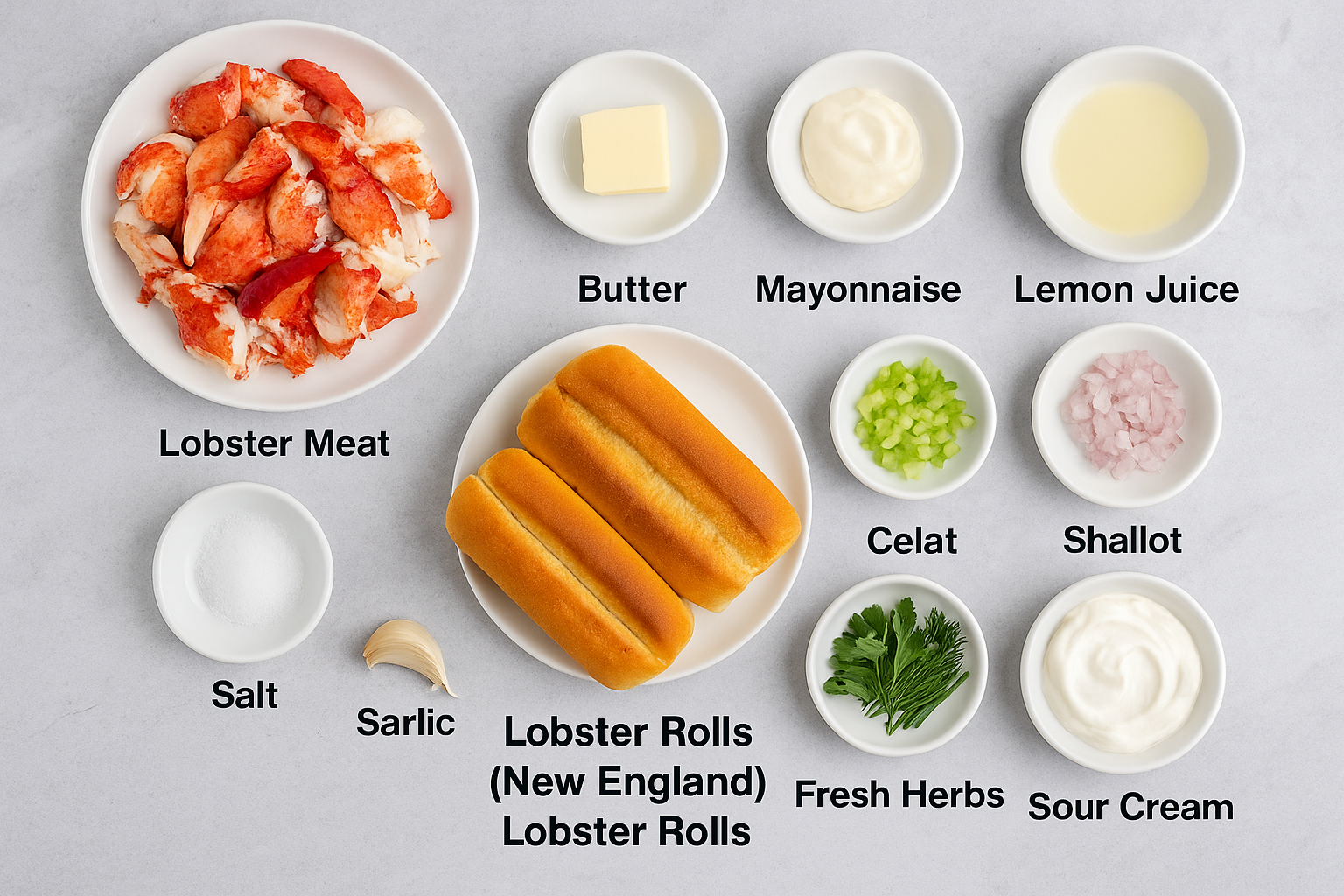
| Ingredient | Purpose |
|---|---|
| Lobster Meat | The centerpiece—tender, sweet meat from claw, tail, or knuckle. |
| Lobster Rolls (Buns) | Toasted and buttered New England–style buns for a crisp contrast. |
| Butter | Used for sautéing lobster and toasting buns, adds richness. |
| Mayonnaise | Forms the creamy base of the dressing. |
| Sour Cream | Adds tang and lightens the mayo for balance. |
| Salt | Enhances all the natural seafood flavors. |
| Lemon Juice | Provides brightness and freshness to the dish. |
| Garlic | Infuses the butter with aromatic flavor. |
| Shallot | Adds a mild onion-like crunch and flavor. |
| Celery | Gives texture and a subtle vegetal note. |
| Fresh Herbs | Bring freshness and a pop of color—think dill, parsley, chives. |
Here are the essential elements:
The quality of the lobster makes or breaks this sandwich. Most traditional rolls use a 4 to 6 oz. portion of fresh, lightly dressed meat.
Variations by State (Maine vs. Connecticut)
The ongoing Maine vs. Connecticut debate has defined lobster roll culture for decades:
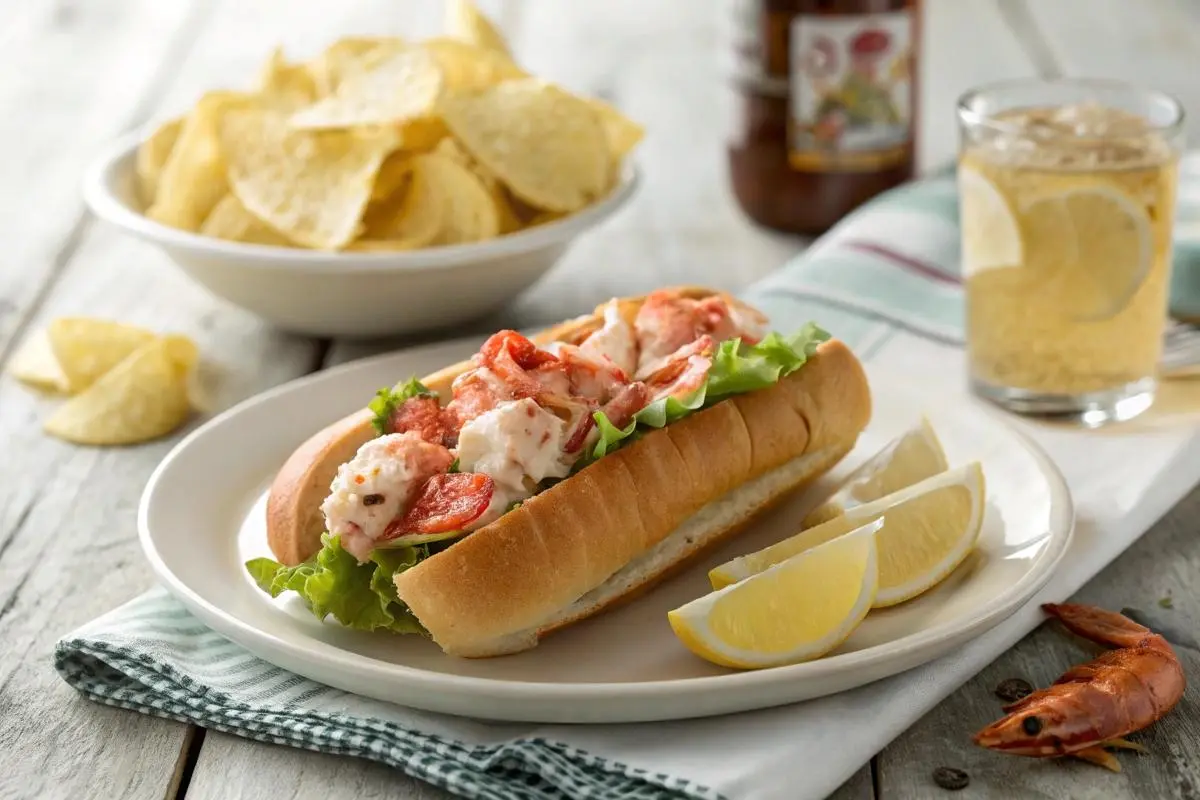
🧊 Maine-Style Lobster Roll
- Served cold
- Dressed with mayonnaise, sometimes celery or chives
- Sometimes includes a splash of lemon
- Chilled and often placed on a buttered, toasted bun
This version is more like a lobster salad sandwich and is the most common style found in the U.S.
🔥 Connecticut-Style Lobster Roll
- Served warm
- Lobster meat is sautéed or gently tossed in drawn butter
- No mayo, no celery—just lobster, butter, bun
- Served immediately for a hot, decadent bite
| Style | Temperature | Dressing | Add-ins |
|---|---|---|---|
| Maine | Cold | Mayonnaise | Celery, lemon |
| Connecticut | Warm | Butter | None |
So, which one’s better? That depends on your taste. Lovers of creamy seafood salad gravitate toward Maine rolls, while butter purists swear by Connecticut.
Looking for more cozy yet upscale meal ideas? Don’t miss our moist bundt cake recipe for the perfect dessert pairing!
How to Make a Lobster Roll at Home
Step-by-Step Recipe for an Authentic Lobster Roll
Making a lobster roll at home is easier than you think—and incredibly rewarding. The key is to let the lobster shine by using high-quality meat and keeping the prep simple.
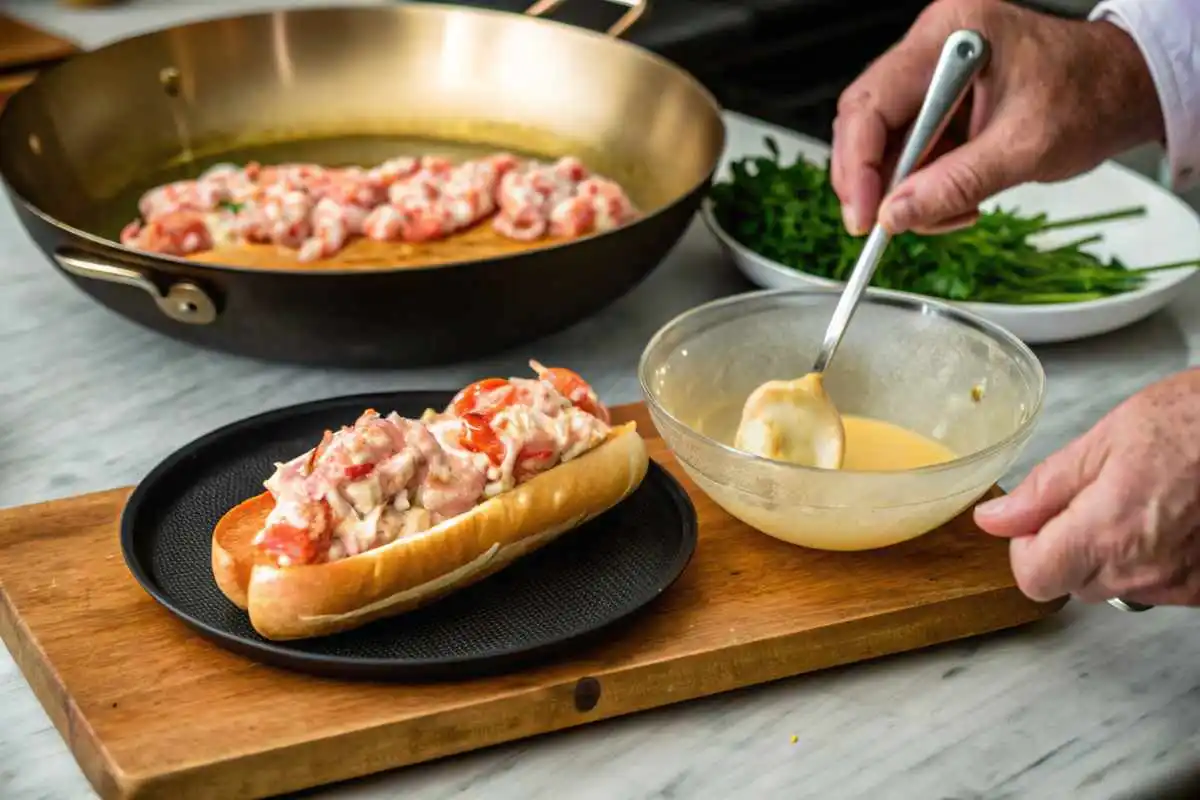
🧾 Ingredients (Serves 2):
- 1/2 lb cooked lobster meat (claw and tail preferred)
- 2 split-top hot dog buns (New England–style if possible)
- 2 tbsp butter (plus more for toasting buns)
- 1–2 tbsp mayonnaise (for Maine-style) or extra melted butter (for CT-style)
- Optional: minced celery, lemon juice, chives, salt & pepper
🛠️ Tools You’ll Need:
- Skillet or griddle for toasting
- Mixing bowl
- Sharp knife (if prepping lobster meat from whole tails)
How to Prepare It (Maine & Connecticut Styles)
🧊 Maine-Style Lobster Roll (Cold)
- Chop the lobster meat into bite-size pieces.
- In a bowl, gently toss with mayonnaise, optional celery, lemon juice, salt, and pepper.
- Lightly toast buns in butter until golden.
- Stuff each bun with chilled lobster salad and garnish with chives if desired.
🔥 Connecticut-Style Lobster Roll (Hot)
- Melt butter in a skillet over medium-low heat.
- Warm the lobster meat gently in butter (do not overcook).
- Toast the buns in butter until golden and crispy.
- Fill each bun with warm, buttery lobster. Serve immediately.
Both versions take less than 15 minutes to prepare if the lobster is pre-cooked. Freshly cooked lobster will require an extra 10–15 minutes for steaming or boiling.
Cooking and Prepping Lobster Perfectly
If you’re starting with live or raw lobster tails, here’s a quick prep method:
| Method | Instructions |
|---|---|
| Boil | Simmer 8–10 minutes in salted water |
| Steam | Steam for 10–12 minutes until opaque |
| Cool & Crack | Let cool, crack shell, remove meat gently |
Use seafood shears or kitchen scissors to remove the shell without damaging the meat. If possible, buy already-shelled meat from a seafood market for ease.
💡 Pro Tip: A squeeze of lemon on top before serving adds a fresh finishing touch—especially for rich, buttery rolls.
Two Types of Lobster Rolls: Hot vs. Cold
Maine-Style: Cold with Mayo
The Maine-style lobster roll is the most commonly found version in the U.S., especially in northern coastal towns. It highlights a refreshing blend of chilled lobster meat lightly dressed with mayonnaise, often with optional celery, chives, or a dash of lemon juice to brighten the flavor.
Key Characteristics:
- Cold lobster meat
- Light mayonnaise coating
- No butter used in the filling
- Often includes minced celery or herbs
- Served in a buttered, toasted split-top bun
The mayo binds the ingredients gently without overpowering the lobster’s sweet, tender profile. It’s ideal for hot summer days and is often served picnic-style with chips and a pickle.
Connecticut-Style: Hot with Butter
The Connecticut-style lobster roll is simpler and arguably more indulgent. Lobster meat is served warm, lightly sautéed or tossed in melted butter, and placed directly into a toasted, buttered bun.
Key Characteristics:
- Warm lobster meat
- No mayo—just drawn butter
- Pure lobster flavor: no herbs, celery, or extra ingredients
- Typically served immediately after cooking
- Bun is crisp and golden from the butter
This style leans richer and more decadent. The buttery texture enhances the brininess of the lobster, creating a melt-in-your-mouth experience.
Side-by-Side Comparison
| Feature | Maine-Style | Connecticut-Style |
|---|---|---|
| Temperature | Cold | Hot |
| Main Dressing | Mayonnaise | Melted Butter |
| Add-Ins | Celery, lemon juice, chives | None |
| Flavor Profile | Creamy, light, refreshing | Rich, buttery, savory |
| Best For | Hot weather, picnics | Warm comfort meals |
Whichever you prefer, the true winner is the fresh lobster—and both styles let that ingredient shine in their own unique way.
Are Lobster Rolls Eaten Hot or Cold?
When to Choose One Style Over the Other
One of the most common questions among lobster lovers is: “Should a lobster roll be served hot or cold?” The truth is, both are correct—it depends entirely on your taste preference and the culinary tradition you align with.
- Hot Lobster Rolls (Connecticut-Style) are perfect for chilly days or when you want a warm, buttery comfort food experience. The melted butter enhances the richness of the lobster, and the flavor is more indulgent and savory.
- Cold Lobster Rolls (Maine-Style) are refreshing and light—ideal for summer lunches, beach days, or cookouts. The mayo-based dressing is minimal and helps maintain a clean, ocean-fresh taste.
If you’re unsure, ask yourself:
- Do you love buttery richness? Go hot.
- Prefer a lighter, salad-style sandwich? Stick with cold.
Many seafood restaurants offer both versions to accommodate different cravings and regional traditions.
Seasonal and Regional Preferences Explained
Your location and the time of year often influence which style you’ll encounter or crave.
| Region | Preferred Style | Notes |
|---|---|---|
| Maine & Northeast | Cold (Mayo) | Most classic and widely served style |
| Connecticut | Hot (Butter) | Original style from the 1920s |
| Midwest & South | Both | Depends on restaurant and trend |
| West Coast | Mostly cold | Influenced by upscale salad trends |
Seasonally, cold rolls dominate summer menus, while hot versions pop up more in fall and spring when diners want something warm and rich but still light compared to heavier meals.
No matter the temperature, one thing’s for sure: lobster rolls are best enjoyed freshly made with real lobster and quality ingredients.
Looking for a refreshing pairing? Try our whipped pink lemonade—a tart and creamy contrast to any lobster roll.
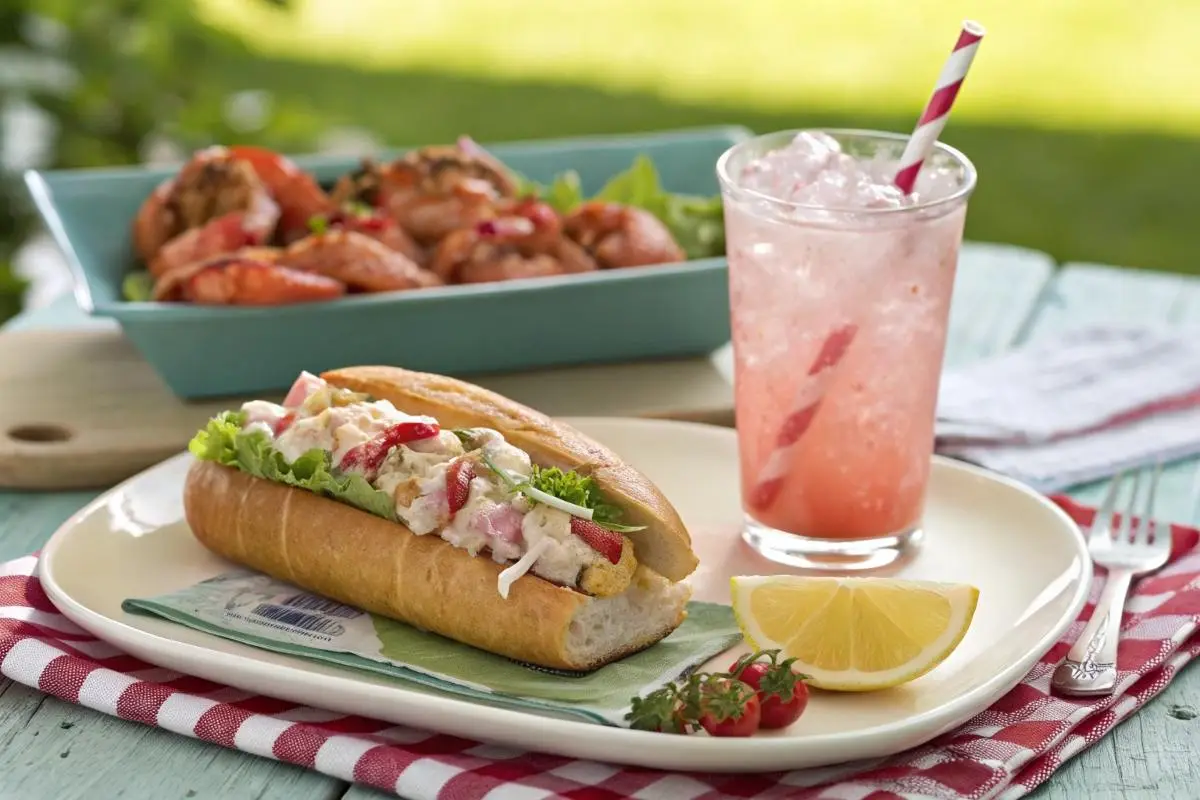
What’s the Difference Between a Lobster Roll and a Po’ Boy?
Comparing Ingredients, Bread, and Preparation
Though both are seafood sandwiches, lobster rolls and po’ boys come from entirely different culinary backgrounds and offer unique flavor experiences.
Let’s break down the major differences:
| Feature | Lobster Roll | Po’ Boy |
|---|---|---|
| Origin | New England (Maine/Connecticut) | Louisiana, specifically New Orleans |
| Seafood Used | Lobster meat (claw, tail, knuckle) | Fried shrimp, oysters, catfish, or roast beef |
| Bread Type | Split-top hot dog bun (soft, lightly toasted) | Crispy French bread or baguette |
| Serving Temp | Hot (butter) or cold (mayo) | Always hot, with deep-fried seafood |
| Dressing | Mayo or butter | Lettuce, tomato, pickles, remoulade, hot sauce |
| Texture | Soft, buttery, and delicate | Crispy, crunchy, and bold |
How Cajun and New England Traditions Diverge
The lobster roll is a showcase for pure, luxurious lobster meat. Its minimalist approach emphasizes freshness, delicacy, and subtle flavor. The bun is soft and usually buttered, and ingredients are few to highlight the seafood.
The po’ boy, on the other hand, is rooted in Cajun and Creole cuisine, known for bold flavors, spice, and texture. Fried shrimp or oysters are served piping hot, piled high on crusty bread with tangy sauces and crisp veggies. It’s hearty, spicy, and deeply satisfying in a different way.
So, while both sandwiches deliver seafood in handheld form, they reflect two distinct American food cultures:
- Lobster Roll = East Coast refinement
- Po’ Boy = Southern boldness
If you’re in the mood for elegance and freshness, reach for a lobster roll. Craving a crunchy, saucy, flavor-packed bite? Go for the po’ boy.
Best Breads, Sides, and Toppings for Lobster Rolls
Why the Right Bun Makes All the Difference
The bun is not just a vehicle for the lobster—it’s a crucial part of the experience. A poorly chosen or poorly prepared roll can completely undercut the flavor and texture of your lobster roll.
The Best Bread Option:
- New England–Style Split-Top Bun: This is the gold standard. It’s soft on the sides, making it easy to butter and toast evenly. The split-top allows the roll to cradle the lobster meat like a basket, rather than closing around it like a hot dog bun.
Alternative Options (if you can’t find split-tops):
- Brioche hot dog buns (for extra richness)
- Soft hoagie rolls (as a backup)
- Toasted Hawaiian rolls (for a sweet-savory twist)
- Lettuce wraps (for low-carb or gluten-free versions)
No matter which you choose, butter and grill the cut sides for that golden, crisp texture that contrasts beautifully with the tender lobster.
Top Pairings: Chips, Slaw, Lemon, and More
A lobster roll is delicious on its own—but even better with the right sides and add-ons. The key is to keep it light so the lobster remains the star.
Best Side Dishes:
- Kettle-cooked potato chips – Classic, salty crunch
- Coleslaw – Creamy or vinegar-based to cut the richness
- Corn on the cob – Especially with a touch of Old Bay or paprika
- Pickles – Sharp, tangy contrast
- Fresh green salad – For a crisp and refreshing balance
- Sweet potato fries – For a bit of sweet-savory indulgence
Garnishes & Add-Ons:
- Lemon wedge – A must for brightness
- Chopped chives or dill – Adds a fresh herb note
- Cracked pepper or Old Bay seasoning – Optional kick
- Drawn butter on the side – For Connecticut-style lovers
| Element | Enhancement |
|---|---|
| Bread | Buttered and griddled for texture |
| Side Dish | Crunchy or fresh to balance soft, rich filling |
| Garnish | Lemon, herbs, or seasoning for visual and flavor pop |
Pairing your lobster roll with the right sides and toppings elevates the entire meal into a complete, satisfying experience.
Looking for the perfect dessert to follow? Don’t miss our moist bundt cake recipe—light, flavorful, and just sweet enough to close the meal beautifully.
Tips for Buying, Storing, and Handling Lobster Meat
Fresh vs. Frozen Lobster Meat
The quality of your lobster roll hinges almost entirely on the freshness of the lobster meat. While fresh lobster is always preferred, frozen lobster meat can still deliver excellent results—if handled properly.
Fresh Lobster:
- Best flavor and texture
- Must be cooked the same day or stored briefly on ice
- Available live or pre-cooked at many seafood markets
Frozen Lobster:
- Convenient and widely available
- Great for off-season or inland kitchens
- Look for flash-frozen tails or claw/knuckle meat
- Thaw slowly in the fridge for 12–24 hours for best texture
💡 Pro Tip: Avoid pre-seasoned or overly processed frozen lobster—go for plain, wild-caught products labeled “raw” or “cooked.”
Storage, Safety, and Prep Hacks
Buying Tips:
- Look for meat that is white and firm, not slimy or mushy
- If buying live, make sure lobsters are active and lively
- Choose claw and knuckle meat for rolls—they’re more tender than tail meat
Storing Tips:
- Fresh, cooked lobster: refrigerate and eat within 24–36 hours
- Live lobsters: keep in the fridge covered with damp newspaper, use within 24 hours
- Frozen lobster: once thawed, use within 1–2 days
Preparation Tips:
- Boil or steam lobster just until opaque and tender—overcooking makes it rubbery
- Use seafood scissors to cut through shells cleanly
- After cooking, cool and remove meat immediately to prevent overcooking from residual heat
- Always check for shell fragments before mixing into your roll
If you’re prepping for a party or crowd, consider buying frozen, pre-shelled meat in bulk—it saves time without sacrificing flavor.
FAQs – Lobster Roll
How to make a lobster roll?
To make a lobster roll, you’ll need fresh lobster meat (preferably claw and knuckle), a split-top bun, and either melted butter (for Connecticut-style) or mayonnaise (for Maine-style). Toast the bun in butter until golden, then fill it with your choice of warm buttery lobster or cold lobster salad. Add optional garnishes like lemon juice, chives, or a pinch of Old Bay seasoning.
Ingredients: What is in a traditional lobster roll?
A traditional lobster roll consists of just a few key ingredients:
- Fresh lobster meat (claw, knuckle, tail)
- Buttered, toasted split-top bun
- Either mayonnaise or melted butter
- Salt, pepper, and optional celery or lemon
The goal is simplicity—nothing should overshadow the sweet, delicate flavor of the lobster.
What is a lobster roll made of?
Lobster rolls are made of tender chunks of cooked lobster, lightly dressed with either mayonnaise or warm butter, and served in a toasted split-top bun. Optional add-ins may include celery, lemon juice, herbs, or spices, depending on the regional style.
What are the 2 different lobster rolls?
There are two primary types of lobster rolls:
- Maine-style – Served cold with mayonnaise, often with celery or lemon juice.
- Connecticut-style – Served warm with melted butter, no mayo or veggies.
Both are delicious in their own way and cater to different preferences.
Are lobster rolls eaten hot or cold?
Lobster rolls can be eaten either hot or cold, depending on the style. Maine-style rolls are cold with mayo, while Connecticut-style rolls are served warm with butter. The temperature is part of what defines each version.
What is the difference between a lobster roll and a po’ boy?
While both are seafood sandwiches, they differ in origin, ingredients, and style:
- Lobster Roll: New England origin, lobster meat, served in a soft, toasted bun with butter or mayo.
- Po’ Boy: Louisiana origin, typically features fried shrimp, oysters, or roast beef on crusty French bread, dressed with lettuce, tomato, pickles, and sauces.
A lobster roll is delicate and buttery, while a po’ boy is bold, crunchy, and hearty.
Conclusion
Whether you’re enjoying one at a seaside shack in Maine or crafting it in your own kitchen, the lobster roll is a celebration of simplicity and freshness. With just a handful of ingredients—tender lobster meat, a toasted bun, and either mayo or butter—you get a dish that’s both luxurious and unfussy. It’s no wonder this East Coast classic has become a national favorite.
From understanding the difference between hot and cold styles to mastering how to make one at home, you’re now equipped to dive into the lobster roll tradition with confidence. So next time you want a taste of the coast, skip the fancy restaurant—grab a bun, some lobster, and make it your way.
PrintLobster Roll: The Ultimate Guide to the East Coast’s Favorite Sandwich
An iconic East Coast summer sandwich, the lobster roll features tender chunks of fresh lobster tucked into a buttery toasted bun. Whether served cold with mayo (Maine-style) or warm with butter (Connecticut-style), this dish is simple, luxurious, and bursting with seaside flavor.
- Prep Time: 10 minutes
- Cook Time: 5 minutes
- Total Time: 15 minutes
- Yield: 2 servings 1x
- Category: Lunch
- Method: Stovetop
- Cuisine: American
Ingredients
-
8 oz cooked lobster meat (claw and tail preferred)
-
2 New England–style split-top hot dog buns
-
2 tbsp butter (plus extra for toasting the buns)
-
1–2 tbsp mayonnaise (for Maine-style)
-
1 celery stalk, finely chopped (optional)
-
A few drops of lemon juice (optional)
-
Chopped chives (optional)
-
Salt and pepper to taste
Instructions
-
Melt the butter in a skillet over medium-low heat.
-
For Connecticut-style: gently warm the lobster meat in butter without overcooking.
-
For Maine-style: chop the lobster into bite-size pieces, then mix with mayonnaise, optional celery, lemon juice, salt, and pepper.
-
Butter the buns and toast them in the skillet until golden and crispy.
-
Fill each bun with the lobster mixture depending on your chosen style.
-
Garnish with chives or a squeeze of lemon if desired. Serve immediately.
Notes
For the best flavor, use fresh lobster or high-quality frozen meat. Avoid overpowering seasonings that might mask the sweet, delicate taste of the lobster.
Nutrition
- Serving Size: 1 roll
- Calories: 420
- Sugar: 2g
- Sodium: 550mg
- Fat: 24g
- Saturated Fat: 10g
- Unsaturated Fat: 12g
- Trans Fat: 0g
- Carbohydrates: 26g
- Fiber: 1g
- Protein: 25g
- Cholesterol: 115mg
Keywords: lobster roll, lobster, sandwich, summer, mayo, butter, Connecticut, Maine
Don’t miss our whipped pink lemonade—a bright and creamy drink that pairs beautifully with any lobster roll meal!
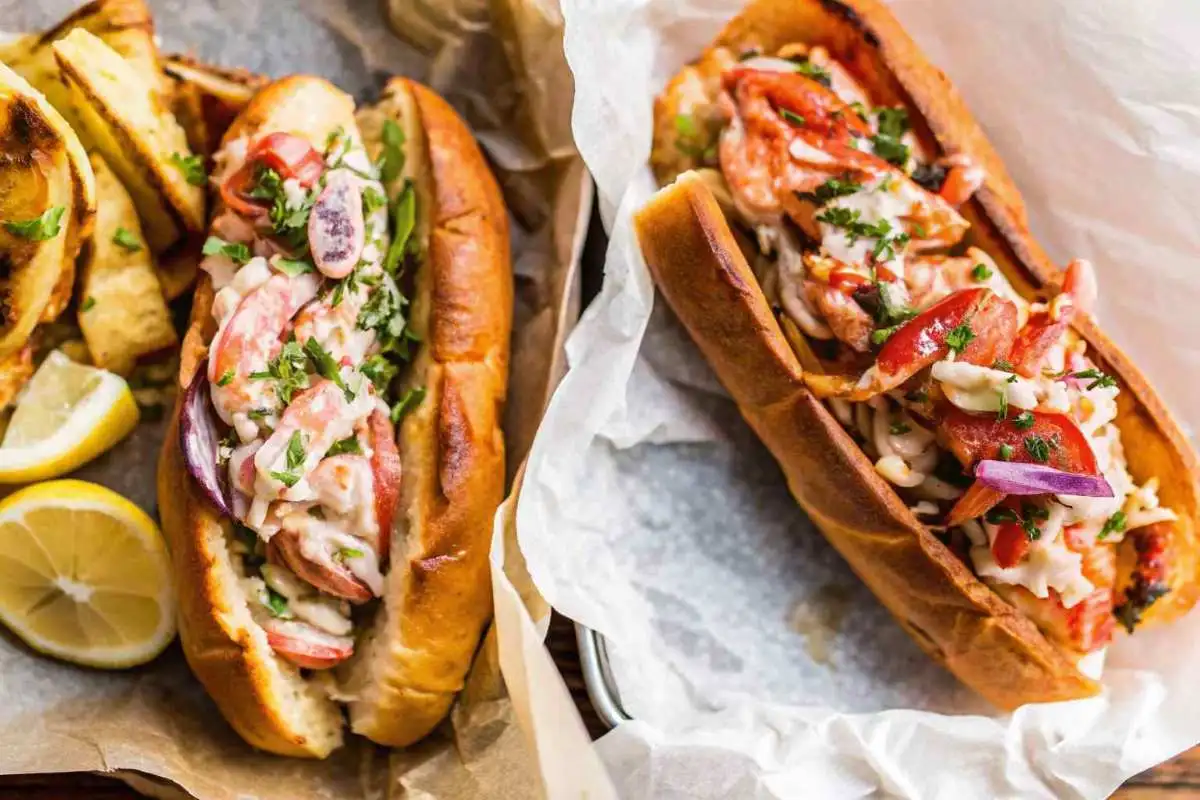

4 thoughts on “Lobster Roll: The Ultimate Guide to the East Coast’s Favorite Sandwich”